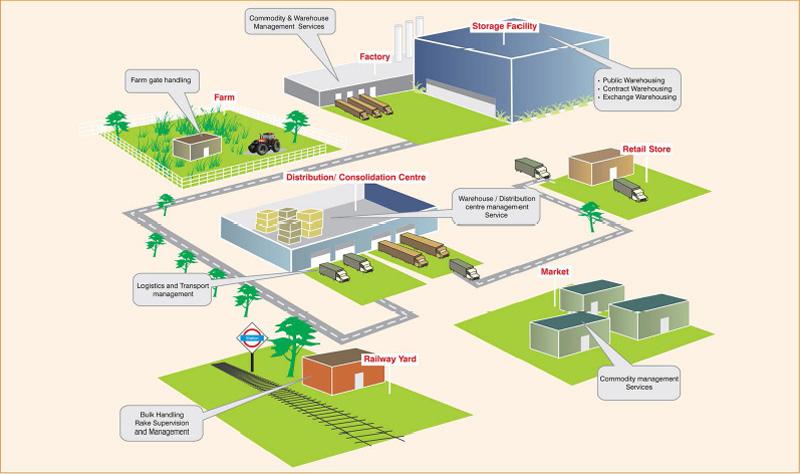
29 minute read
COVER STORY
BIG BOX BOOM
Once regarded as a backroom support function, warehousing and distribution are moving out of the shadows and getting into the spotlight. In the past few years, these have undergone a major identity shift. Now, warehouses hum with cutting-edge technology, and the C-suite is beginning to recognize the essential role it plays in driving profitability. This wide-reaching shift in how people buy goods & services has pushed more DCs into the direct-to-consumer fulfillment game and intensified the pressure to provide speedy service. The pandemic has brought forward the digitalization story. Moreover, with the advent of always-on e-commerce, the demand for faster responses, and the need to manage a larger number of SKUs with fewer errors, warehouses need to scale up and meet the standards of an intelligent, efficient, and automated warehouse. Looking ahead, a surge in the preference for digital transformation will bring fundamental changes in the way warehouses operate today and this cover story essentially captures the aspects of the changing facets of New Age Warehouses in India…
Advertisement
THE country’s warehousing sector gained prominence in the last 4-5 years as the ecosystem for efficient supply chain had been triggered by the implementation of GST in 2017. In the same year, the Central Government’s grant of ‘Infrastructure Status’ to the logistics sector including warehousing, had also proved to be a catalyst. Since then, this segment has undergone a rapid change towards institutionalization. From the supply side, the warehousing segment, earlier dominated by unorganized players, has increasingly attracted global players and accelerated formalization of the sector. The regulatory system is also offering a fillip to the sector with many state governments announcing dedicated logistics sector policies. On the demand side, occupier expectations in terms of compliant and quality warehousing space, have catapulted to the next level with increasing dominance of e-commerce, 3PL players and corporates with global operations, states a recent report by Knight Frank.
A recent JLL report stated that the Indian warehousing industry is in a three-dimensional growth path; growing by length across cities from suburban to urban areas, growing by breadth across India’s tier II and tier III cities along with tier I; and growing in height by venturing into multi-storey warehousing spaces. As we have seen in the last few years, particularly the warehousing sector has achieved new benchmarks on demand, supply, and investments. Noteworthy is the fact that these peaks have been achieved on an improving metric of quality – for both product and the enterprise. While Covid-19 has had a significant impact on the Indian economy, the warehousing sector provides hope considering it will be better placed compared to residential, retail and office. The Warehouse & Logistics Sector is limping back to a semblance of normalcy after a period of disruption due to the global pandemic. Experts also opine the same sentiments when it comes to warehousing uptick.
According to Balbirsingh Khalsa,
National Director Industrial &
Logistics, Knight Frank India, “The most important change the pandemic has brought about; mostly with warehousing pertaining to e-commerce is a push for in-city warehousing. As the pandemic and the subsequent lockdown pushed most demand for essential goods online, the pandemic has also brought about the use of live tracking to better track delivery status. Many 3PL companies have also started using UV lights and disinfectants to maintain better sanitation standards. The DGCA (Directorate General of Civil Aviation) has also permitted the test of drones for delivery for 13 e-commerce companies, owing to the stress the sector was facing due to the lockdown.”
Giving 3PL perspective, R Shankar, CEO, TVS SCS, highlights that Covid impacted supply chain severely, hence the effects will be long lasting. The key ones are listed below: 1. Safety & Hygiene – For health and safety of workforce, some form of social distancing, sanitization and hygiene will be practiced.
2. Additional inventory stock –
During Covid, lean inventory left manufacturers with production stoppage, hence practice of keeping buffer stock will be seen. This may lead to warehouse capacity expansion.
3. Warehouse automation & technology adoption – Shortage of labor and need for speedy deliveries both have stressed on the importance of automated warehousing infrastructure. Even technology investment will pick up higher momentum as the visibility of supply chain is essential to overcome the abrupt challenges. Inventory visibility will be the top-most need. – Many companies are bringing manufacturing closure to home for better control and are trying to be less reliant on the global supply chain practices. Another change is decentralized warehousing to meet same day/ next day deliveries. Being closer to the customer decreases transportation costs and reduces the risk of supply chain disruption. Both these strategies will involve reassessing the existing supply chain network, making it more agile, accessible and technologically superior.
5. Adoption of E-commerce & Omnichannel distribution – e-commerce boom won’t subside post Covid.
Omni-channel will also exist to allow customer to buy in-store/ online. This change will impact the warehouse operations, material flow, processes and storage strategies.
Seconding his thoughts, Rajesh
Makkolath – Head Business Development India, Godrej Storage
Solutions, states, “Pandemic resulted in huge supply chain disruptions and all clients will try to de-risk themselves in the future by moving from ‘just-in-time’ to ‘just-in-case’ for stocking. The other prominent change was the shift towards online buying across all categories. This will have a permanent effect on fulfilment models from pure online or offline to omnichannel models gaining traction.”
CHALLENGES IN BRINGING ABOUT TRANSFORMATION
As distribution operations become increasingly complex and labor costs continue to climb, more supply chain executives will be looking to technology for help managing fulfillment operations. According to the study, over the next 10 years, companies will increasingly implement robust software that can orchestrate their inventory, people, and automation requirements. Prior to the pandemic, the warehouses were labor

Warehouses in upstream supply chain (Factory warehouses, CDCs, etc.) are clearly going the AS/RS, pallet shuttle way for most industries. Thanks to increasing e-commerce adoption, warehouses in downstream supply chain are moving away from case handling to piece handling in a large way. Technologies enabling unit picking and sortation (from PTLs to sorters) would be quite relevant in our warehousing landscape in the days to come. WMS (to meet such operations complexity) would see big adoption. Besides, we clearly see a big shift towards automation in all aspects of DC design. While technology choice and applicability vary by industry, geography and scale, ‘Goods to Man’ technologies for pallet, case and unit handling like ASRS, pallet and case shuttles, conveyors and AGVs for movement, sorters (Piece / Carton) are becoming increasingly common place. We expect these trends to accelerate.
intensive in nature and there wasn’t any need felt to innovate or adopt big technological changes. However, the social distancing, health and safety protocols brought to fore due to the pandemic are pushing warehouses to accelerate automation and decrease human dependency. But what’s the ground reality and why was there such a resistance towards opting for automation before Covid struck us? Experts believe that the biggest lacuna comes from the mindset of people in adapting to the changes.
As Ravi Soni, CEO, Grus & Grade, states, “We have been associated with many small and medium industry leaders and found that the greatest bottleneck in adoption of these technologies is the mindset. Many of these industry leaders, though acknowledge the need for change, but there is lack of willingness in them to either accept the change or adopt the change. Any new technological solution needs huge investment, and without a clarity on ROI or the actual benefit derived (used case) out of adopting these technological solutions, the mindset to invest for technological upgradation is not possible.”
The second major challenge is the technology itself. Most of these disruptive technologies are still in their nascent stages of development with extremely limited data to substantiate its actual value for the industry. Few big players like Amazon or Walmart can absorb some sunk cost during research and development or experimentation phase. The same bandwidth is not available with small and medium players. The third major challenge is at the implementation of these solutions by early adopters as it requires a complete change management of the entire enterprise. Thus, this demands a cultural shift in existing company practice. Unless the employees also see the benefit of these disruptive technologies or they are made the stakeholders in the change platform, there is going to be an internal resistance.
Next major challenge in bringing these solutions are the extraneous
As the Indian warehousing market moves towards formalization, many new formats on warehouse development and operations will be explored in the country. One such format prevalent in developed markets globally and in Asian cities like Hong Kong, Singapore and Shanghai is the multi-storey in-city warehouse format. At present in India, old makeshift industrial galas and other commercial spaces are being utilized for such storage requirements and in-city warehousing in true sense is yet to mark a beginning in the country. The in-city structures easily facilitate the short delivery timelines of e-commerce and fast-moving segments like retail, FMCG and perishables, thereby building a case for them in India too. A multi-storey in-city warehouse can be any structure with more than 2 storeys (G+1 upwards). While a 5-6 storey warehouse is more popular in Japan and Singapore, 12-storey warehouses are popular in Hong Kong.
Mayur Tolia, Project Manager, Lafarge Holcim IT Asia
Automation in warehouses offers tangible gains such as improved capacity utilization, allowing sharing of underutilized space; improved man-machine coordination, leading to higher standards of compliance to safety and SOPs; improved throughput; better visibility allowing faster decision making on demandsupply and inventory level plans and reduced damages/ pilferages and better inventory cost. Indian warehousing space may see extensive and intelligent deployment of Artificial Intelligence & Robotics and Dynamic Shelf space in time to come. While the e-commerce industry is a frontrunner on this, the adaption of the technology in traditional manufacturing set-up especially capital-intensive segments like steel, cement, coal, etc., would be the next level adaptors.

challenges caused by political, cultural, and social factors. We often forget the role of extraneous reasons while adopting any change, be it company specific, sector specific or industry specific. “We need to establish a steady flow of communication before adopting any change in the existing system and integrate all the stakeholders in the information flow. The knowledge dissemination for adoption of disruptive technology and a steady flow of communication between all the layers of the value chain is a must for a revolutionary change in application of industry 4.0 solutions for advanced warehouse management,” Ravi adds.
According to Nataraja
Subramanian, MD, Miebach
Consulting India Pvt. Ltd., the foremost challenge is in establishing the business case for automation here. “We’ve a business case framework through which we seek information relevant for business case modelling from about 50 value streams within supply chain. Some of these value streams sit in other parts of supply chain (well beyond the DC) but would be positively impacted by an automation decision in DC. Most often people don’t see this. Trying to find a business case within one silo of supply chain, in our humble view, results in suboptimal decisions being made in most use cases. We at Miebach see this as an important responsibility of ecosystem partners to support business leaders with such enablers so that they could take right decisions.”
Other challenges in the transformation are the usual suspects – “On time, in budget, go live and demonstrating value delivery to business in near term. We at Miebach follow an internally developed holistic metrics framework called FOCUS (Finance, Operations, Customer Service, Safety) to measure DC operations efficacy. We are seeing big performance leaps in all metrics, which fold into FOCUS (particularly storage density, productivity and accuracy) in all implementations over time,” states Subramanian.
Mayur Tolia highlights the following challenges: ◆ Lack of low-cost ready solutions/ technology know-how ◆ Buy-in of the workforce especially the laborers and the warehouse operators who had their own fears of losing jobs and investing in infrastructure respectively ◆ Design to deployment remained a complete FIRST TIMER experience for the typical cement warehouse automation ◆ Change management w.r.t. training the warehouse caretakers on technicalities of the conveyors (loading/unloading machines), keeping in mind both operational efficiency and safety remained a big challenge.
UPCOMING POLICY DEVELOPMENTS
The government has been proactive and made necessary policy changes and put forth strategies to reinforce its manufacturing and logistics goals. A slew of initiatives was announced to aid the sector such as the National Investment Grid, Central Single Window Clearance (industrial and warehousing) and PLI with Stakeholder perceptions, for instance among many others.
Upcoming policy developments are aiming to create single window e-logistics market to cut the logistics costs. “Policy will aim for seamless multi-modal freight transfer and make freight movement for key commodities cost-efficient. But policy should also facilitate alignment between the Centre and the states otherwise it will be hard to implement,” states R Shankar. Here are a few suggestions by R Shankar for the policymakers: ◆ Logistics policy needs to be developed covering first mile and last mile linkage, post identification of potential multimodal corridors after mapping current infrastructure, industrial clusters and analysis of origin and destination cargo. ◆ Any infrastructure development should not be looked at in isolation, but as part of an integrated multimodal system of transport. ◆ Any new infrastructure such as port/ airport should not be developed without intermodal connectivity. ◆ Terminals and cargo handling facilities should be set up at strategic locations with adequate connectivity to road and rail. ◆ Last-mile connectivity should be encouraged through PPP in a timebound manner. ◆ Logistics Council should be set up in co-ordination with infrastructure service providers and 3PL service providers to facilitate effective
collaboration.
Rajesh Makkolath feels that all the 29 states should have the logistics and warehousing policy framework in place (currently 8 states have a valid one). This will aid both the occupier and the developer. There needs to be standardization in logistics as far as material handling equipment/warehouse spaces/racks/pallets etc., are concerned, which will help drive interoperability, compatibility, repeatability and quality.
NEW AGE WAREHOUSING PRACTICES
Globally, e-commerce has caused a wave of technological innovation in warehousing. It started with Warehouse Management Software (WMS) that reduced the burden of data entry and paper records, to conveyor belts and pick-to-light systems that helped increase the speed of sorting and picking. Globally, warehouses have come leap years ahead in a matter of just two decades. Smart warehouses, like smartphones, have become common parlance. Also referred to as intelligent warehouses or warehouses that think, all gadgets and devices within a smart warehouse are connected to each other via Internet and can effectively perform multiple operations simultaneously. Another trending feature in global e-commerce warehouse is IoT, a system that connects and integrates electronic devices via Internet such that they can send and receive data from each other and perform their respective functions in sync with one another. One more important innovation is augmented reality, a real time integration of digital information with the existing environment, e.g., vision picking. Besides, there is 3D printing, robotics, self-driving vehicles, and drones that have greatly enhanced e-commerce warehousing efficiency in the West. The quest for innovation is ongoing and the new technologies continue to enter warehouses, as per the Knight Frank report on Warehousing.
According to Balbirsingh Khalsa, “At present, the Indian warehousing market is being driven by the expansionary business model adopted by most e-commerce companies in the country. The rise in e-commerce activities has induced the use of certain innovative practices to improve efficiency in the supply chain process. Warehousing Management Software (WMS) was the first major technological breakthrough, as a replacement for the enormous paper trails that warehouses used to produce for punching in and out. Then there came conveyor belts and pick-up machines that increased the speed of picking and sorting. Within two decades, global warehouses, adopting IoT (Internet of things), have become smart warehouses that have multiple gadgets/equipment connected through the internet and can perform multiple tasks simultaneously while constantly in sync with each other. Other innovations include the use of Augmented Reality (AR), 3D printing, robotics, drones, self-driving vehicles have all aided in the efficiency of warehouses.”
To increase both the speed and convenience of pickup and delivery, Walmart is planning to scale several stores, so that can serve as local fulfillment centers. The company describes these centers as compact, modular warehouses built within, or added to, a store. The

End to End inventory and warehouse management for Agri commodities used by NBHC
Ravi Soni, CEO, Grus & Grade
I see COVID-19 as a blessing in disguise. The biggest benefit of this pandemic is setting of the ‘New Abnormal’. I do not term it as a new normal. The greatest challenge in the adoption of new age technology by first- or second-generation industry leaders was the mindset. No one felt there is a need, even if there was a latent need, it was not given any prominence as there were no demonstrable benefit. Who wants to invest when things are normal? Warehouse management solutions are no exception to the positive impact of Covid. Industry has been forced to think beyond normal to satisfy the huge demand created by e-commerce players during Covid-19. This needed a complete transformation and industry is transforming to need created by the ‘new abnormal’.
company will use these centers to store both fresh and frozen items, as well as consumables and electronics. But you will not see people in these centers. Rather than an associate walking the store to fulfill an order from our shelves, automated bots retrieve the items from within the fulfillment center. Items are then brought to a picking workstation for the order to be assembled. Once the order is collected the system stores it until it is ready for a customer or delivery driver to collect. These are the Next Generation Warehousing practices we are talking about.
Today’s warehouses are being completely transformed by advances in technology. As e-commerce continues to grow, these changes are happening quickly, as stated by R Shankar… ◆ Automatic data collection – Use of barcodes and radio frequency identification (RFID) to expedite the data collection process and maintain accuracy. Barcode scanners are further being replaced with more innovative and easier scanning technology solutions such as mobile, wearable, and augmented reality, aiding better efficiency. ◆ Big Data – Large data sets collected with above automation can be analyzed computationally to reveal larger patterns and trends that might not be obvious to the human eye. These studies help to balance inventory turnover ratio and examine how operations could be streamlined to their fullest capacity. ◆ Warehouse automaton – Use of
AS/RS increases the efficiency of
picking and packing operations and reduces lost or misplaced materials and picking errors. ◆ WMS – A good warehouse management solution will consolidate orders so that travel time is minimized during picking, increasing efficiency and throughput.
It can integrate with ERP / inventory management system so that inventory stays in sync, increasing accuracy and reducing costs. Further, companies can integrate AS/
RS and WMS solutions for increased efficiency and productivity. ◆ Internet of Things (IoT) – IoT facilitates hands-free operation, realtime information access, reduced labor costs, increased speed, accurate shipping, and better information visibility. ◆ Tablet Computers – Tablets are being replaced by PCs and help provide real-time information, improve communication, offer enhanced imaging capability that helps workers capture signatures, identify damaged products, and handle inspection checks. ◆ Cloud computing – This enables remote access through multiple devices, including mobile devices and eliminates the need for internal
IT infrastructure. ◆ Robotics – Robotics reduces manpower intervention in repetitive and routine tasks, improves efficiency and TAT. ◆ e-Commerce boom demands fast logistics turnaround time (TAT), which drives the adoption of augmented reality, automation, and autonomous vehicles within controlled environments.
According to Rajesh Makkolath, “More Grade A warehouses will certainly have a positive effect on the intra-logistics space within supply chain ecosystem. It aids in organized storage as clients looks for higher throughputs and accuracy. Modern warehouses are also automated to de-risk manual operations.” Mayur Tolia shares that the Indian warehousing space may see extensive and intelligent deployment of Artificial Intelligence & Robotics and Dynamic Shelf space in time to come. While the e-commerce industry is a frontrunner on this, the adaption of the technology in traditional manufacturing set-up especially capitalintensive segments like steel, cement, coal, etc., would be the next level adaptors.
With the complexity and diversity in customer orders and preferences for quality and timely order deliveries, industry has felt the need for transformative change in warehouse management and operations. The entire supply chain is witnessing a revolutionary change due to customized orders, which tend to be of small batch size but with high variety. These customizations require that the new age warehouse should be equipped with real time data management solutions and contextual information.
Adds Ravi Soni, “We are witnessing an extremely high volatility in frequencies of customer requirements and to support this variability in demand over time

R Shankar, CEO, TVS SCS
TVS SCS operates more than 13 mn sq.ft. warehousing space in India, which are spread across all the states. This is mix of 300+ consolidated and dedicated facilities. Our strategy is to relook at strategic placement of consolidated facilities and well equip our consolidated (multi-customer) facilities with infra, technology and trained manpower. In tune with this, we are looking at the placement of the warehouse to bring more customers under the shared facility and optimize the cost passing benefit to customer. We are converting our consol facilities into state-of-art facilities with modern infrastructure leveraging vertical space. We have implemented WMS, TMS, IT dashboards with a view to achieve improved visibility and efficiency across all the stages of operations.

Balbirsingh Khalsa, National Director Industrial & Logistics, Knight Frank India
Warehouses in India, compared to their global counterparts, are still far behind in terms of technology and penetration. The presence of technology is very minimal, and its nature is to serve basic tasks such as Radio Frequency Identification (RFID), scanners, conveyor belts, basic forklifts, and wearable technology such as smart glasses. Furthermore, this limited technology is used primarily by selected industries such as e-commerce and 3PLs. The unorganized nature of warehousing, paired with the availability of cheap labor, has largely been responsible for the lack of technology being adopted by warehouses in India. However, the entry of a few institutional players, organized and good quality warehouses are easy to find. Furthermore, the entry of organized players has also facilitated the entry of robots on Indian warehouses, albeit on a small scale. Nevertheless, the high dependency on human labor has been a prime reason for the slow technological evolution in the warehousing space.
requires a complete synchronization of purchase orders to support production process and on time-order fulfilment mechanism. If there are inefficiencies in order picking process, the entire supply chain is disrupted.”
The next generation warehouse management solution needs to be equipped with an inventory management system with a real-time data management tool supported by IoT technology. Application of real-time data management and analytical tools with advanced forecasting mechanism using artificial intelligence is being adopted by the industry. Application of robotics for inventory management and movement and augmented reality for identification and location of SKUs has transformed the traditional methods of organized inventory management system. The greatest challenge in the entire value chain is the problem of trust, authenticity, and genuineness of the goods. Smart contract and distributive ledger technology or in simpler words, blockchain technology has immense application for ensuring transparency and traceability of goods & services on a real-time basis.
Amazon, for instance, has adopted “Chaotic Storage” system for order management solution. As against the traditional system of an organized warehouse with neatly managed shelves stocked with similar products managed in alphabetical order of the SKUs, in the ‘Chaotic System’, incoming products are placed randomly on any available shelving space within a warehouse, irrespective of its itemized location. The ‘Chaotic System’ requires a lot of application of robotics and augmented reality technology in combination with advanced analytical tools to manage both the demand forecast and supply management. These are not very structured array of inventory management solutions with any specific pattern for storage. These warehouses are however equipped with automated storage and retrieval system (AR-RS). These warehouses are equipped to store and retrieve inventory on demand. The AR-VS consists of shuttles, cranes, carousels, vertical lift modules (VLM), micro-loads, mini-loads, unitloads, robotic arms and conveyors, image processing & augmented reality toolkit, etc.
Impact of Industry 4.0 for modern warehouse management requires management of inventory through four parameters, viz. inventory process management system, inventory classification, inventory system parameters and inventory system review. All these four parameters need to be digitalized to have a real time data management and process accessible to all, anytime and every time. Cloud storage and cloud computing technologies are thus not just a necessity for survival but are also inevitable change that will be a reality across all the value chain in near future.
The other example pertains to Agri value chain and cold storage for perishable agricultural commodities. National Bulk Handling Corporation (NBHC), for instance, has set a benchmark with a customized state-of-the-art warehouse management solution, wide service network and assurance of system, process, and quality. An integrated farm to fork inventory management is a must for modern agri commodities warehouse solution. This must be an end-to-end solution as depicted in the figure below:
Four key aspects new age warehouse should have are Efficiency, Flexibility, Security and Sustainability, believes R Shankar: • Efficiency includes effective space utilization, automation and technology
EFFECTIVE SPACE UTILIZATION
◆ Larger facilities with increased cubic space utilization ◆ Higher bays with vertical storage with adequate circulation paths for personnel and MHEs
AUTOMATION
◆ Tighter inventory control through automation ◆ Use of MHEs, conveyer belts, AS/RS system to improve the accessibility of goods
TECHNOLOGY
◆ Use of RFID and barcode technology,
WMS & TMS ◆ Further usage of new age technologies to drive analytics and inventory
optimization ◆ Flexibility – This involves multiple options to customers; wide range of storage alternatives, picking alternatives and MHEs, addressing seasonal or permanent demand changes, value addition facilities across multiple sectors with sector specific racking, flexibility in pricing models (fixed/ variable) ◆ Security – Use of security systems for safekeeping of products (CCTV,
RFID monitoring for high value, motion sensors) ◆ Sustainability – This includes health & fire safety provisions, proper ventilation, solar panels on the warehouse roof, use of motion sensors to only illuminate areas in use, intelligent electrical systems to take benefit of off-peak power, green warehousing with rainwater harvesting.
In line with this, Rajesh Makkolath avers, “New age warehouses will have minimal human interphases. It will use digital technology extensively for meeting the changing demands of fulfilment, that is placed on them.” There are some distinct dimensions, which will guide the new age warehouses: ◆ Connectivity: Real-time
Information ◆ Choice: Customization ◆ Performance: Proactive actions ◆ Safety: Compliance ◆ Motivation: Engagement ◆ Flexibility: Storage & handling ◆ Reliability: Automation ◆ Scalability: Align business growth & peaks ◆ Security: Prevent variations
Giving industry specific example, Mayur Tolia informs, “In my previous organization, a cement manufacturing company, warehouse automation has been an Industry First in India. Custom built mobile conveyor belts were deployed to automate the cement unloading/ storage and re-loading operations.”
Nataraja Subramanian is of the view that while innovation is a great thing, we feel India / APAC region needs three things more than innovation in its current maturity level: Metrics obsession; SOPs; and Rigor (to stay close to SOP’s with an eye on metrics every single day and day after day). “Our attempt in our engagements is to focus on building above foundations for our customers while leveraging the great innovations coming from supplier partners globally.”
STEP BY STEP APPROACH TO GO FOR MODERNIZATION
Going for automation needs a lot of collaboration and expert advices from industry leaders. Offering a brilliant parallel, Nataraja Subramanian states, “Applied in automation decision context, we often take inspiration from the adage – one man’s meat could be another man’s poison! It is important to take a pragmatic ‘horses for the courses’ approach here and stay away from the temptation to automate for automation’s sake.” We follow a 3-step process as below: ◆ Step 1: Evaluate / Establish automation feasibility at high level.
It is important to be technology and supplier agnostic in this step.
Tabling a 3D decision making matrix (covering manual, mechanized and automated alternatives with relevant holistic business case) to business is an important enabler to a right decision.
◆- Step 2: Evaluate right supply / vendor partners for tech choices you have made in step 1. Project feasible project delivery timelines to leadership at this stage.
◆ Step 3: Invest in a strong PMO team which interfaces with multiple stakeholders (Civil, Electrical, F&S,
IT, Storage, Handling suppliers) to ensure timely delivery.
Agrees Ravi Soni, “The modern warehouse needs a harmonization of physical and digital infrastructure. Often the legacy model neglected even the rudimentary application of technology. The leapfrogging thus would need a lot of collaboration from various industries. We need to identify the right mix of technology for a particular industry, sector, or company. Once, the need has been identified by the company, they need to plan the investment needed. We all are resource constrained, and a capital expenditure with unknown return on investment has an intrinsic risk. Adoption of the technology by

Rajesh Makkolath – Head Business Development India, Godrej Storage Solutions
Increase in number of Grade A warehouses will certainly have a positive effect on the intra-logistics space within supply chain ecosystem. It aids in organized storage as clients looks for higher throughputs and accuracy. Modern warehouses are also automated to de-risk manual operations. New age warehouses will have minimal human interphases. It will use digital technology extensively for meeting the changing demands of fulfilment, that is placed on them. As businesses transform in an economy of choice (personalization/time/ quantity, etc.); supply chain & warehouse space will align accordingly. This will be done by all activities being completely technology-enabled and digital will be the backbone.
industry leaders with a demonstration of the benefits derived can motivate the small players. We need to find means to make the warehouse management technology solutions from being a onetime investment to a recurring operating cost for the small players. SaaS model can thus be another possible solution.”
Mayur Tolia lists step by step approach to go for incremental transformation in warehousing: ◆ Gather, analyze and define current operational efficiencies and improvement potential ◆ Set-up clear objectives on what is expected out of automation ◆ Identify right technology solution and partner. ◆ Warehouse automations would need continual tweaking and adaptations and hence important to have the supplier work along with the organization in the implementation and subsequent on-going support phase. ◆ Change management - involving all impacted stakeholders in design and development of the solution.
Quite often the most critical and important inputs which make or fail an automation initiative come from the often most ignored stake holder as low as the floor maids, security guard, labourer. ◆ Realign the existing processes and make amendments as required to accommodate and gel with the TO BE process post automation. A solution aimed only at automating existing processes without addressing the inherent inefficiencies would see a failure much sooner than later. ◆ Keep in mind the human factor and quality of work-life and safety aspects along with the commercial aspects while deploying an automation solution.
ADVANCEMENTS THE WAREHOUSING SPACE IS SET TO WITNESS…
Technology continues to drive warehousing forward, with a wide range that enables warehouse workers to become more efficient and productive while also reducing picking and shipping errors. In fact, according to a 2020 Study, 74% of warehouses are now providing staff with moderate to advanced technology, with these three types being the most common: Internet of Things (IoT): 72%; Tablet computers: 72%; Barcode scanning: 70%.
Like in any other industry, customization is taking centerstage in the modern warehouses too, which itself is offering warehousing service providers not only an edge but also a competitive advantage to gain first mover advantage. To ensure that, modern warehouses are incorporating major trends to achieve operational success: enhancing the customer experience, implementing smart integrations across systems, and utilizing advanced planning tools to support sustainability.
Warehouses, and the supply chain, together are moving to a more integrated approach that supports transparency and visibility for the warehouse and across all key stakeholders. According to R Shankar, these are the top 5 advancements the warehousing will witness in the next few years…
◆ On-demand warehousing is a trend to emerge from the need for greater warehouse flexibility to accommodate temporary demand for additional capacity. This trend enables companies who have built their warehouse to handle their peak season demands to monetize unused space during quieter times of the year. ◆ Automation as a service is a fastgrowing business model where customers can deploy automation on an as needed basis. It is gaining prominence because it provides facilities with the ability to rapidly scale up and down as demand dictates and allows buyers to expand or experiment with technologies. ◆ Advances in tracking and visibility – IoT fosters better communication and collaboration between supply chain partners, plus greater accountability across the board. IoT adoption will continue to grow over the next decade as technology costs are now within reach for many warehouses and logistics operations. ◆ Mobility is also playing a significant role in the modern warehouse. The
proliferation of mobile devices, such as smartphones and tablets, means warehouse workers and logistics partners has a variety of tools and resources readily available. ◆ Big data and machine learning are poised to transform warehouse operations over the next few years. Order accuracy, fulfillment time and inventory accuracy are all
KPIs that can be optimized using
AI. It can be also applied to safety & productivity. AI can be used to automate tasks and decision-making.
According to Rajesh Makkolath, the upcoming changes include: Organized storages; Automation; Movement to tier II & III cities; Institutionalization of warehousing segment; and e-commerce to further expand its position as the key occupier group. “As businesses transform in an economy of choice (personalization/time/quantity, etc.); supply chain & warehouse space will align accordingly. This will be done by all activities being completely technologyenabled and digital will be the backbone,” believes Rajesh Makkolath. “In my view, the next wave of warehouse upgradation would be with the conventional industry segments especially the commodity segment,” adds Mayur Tolia. Ravi Soni forecasts that blockchain technologies have not been adopted by any of the warehousing companies or sector. There is a huge gap as far as traceability and transparency in supply chain is concerned. Blockchain is the most apt technology with demonstrable use cases in the sector. Early adopters are going to be the key beneficiaries.
Warehouse digitalization is a reality that the warehousing industry must come to terms with, in order to sustain and thrive amongst increasing competition and market pressures. The smart warehouse, which appears only as a disruptive force as of now, is likely to become the norm within the next ten years.





